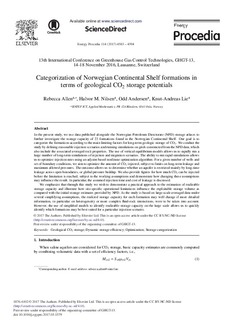| dc.contributor.author | Allen, Rebecca | |
| dc.contributor.author | Nilsen, Halvor Møll | |
| dc.contributor.author | Andersen, Odd | |
| dc.contributor.author | Lie, Knut-Andreas | |
| dc.date.accessioned | 2017-08-24T09:28:42Z | |
| dc.date.available | 2017-08-24T09:28:42Z | |
| dc.date.created | 2017-08-03T10:33:09Z | |
| dc.date.issued | 2017 | |
| dc.identifier.citation | Energy Procedia. 2017, 114 4566-4577. | nb_NO |
| dc.identifier.issn | 1876-6102 | |
| dc.identifier.uri | http://hdl.handle.net/11250/2451718 | |
| dc.description.abstract | In the present study, we use data published alongside the Norwegian Petroleum Directorate (NPD) storage atlases to further investigate the storage capacity of 23 formations found in the Norwegian Continental Shelf. Our goal is to categorize the formations according to the main limiting factors for long-term geologic storage of CO2 . We conduct the study by defining reasonable injection scenarios and running simulations on grids constructed from the NPD data, which also include the associated averaged rock properties. The use of vertical-equilibrium models allows us to rapidly run a large number of long-term simulations of injection and migration scenarios. The ability to run rapid simulations allows us to optimize injection rates using an adjoint-based nonlinear optimization algorithm. For a given number of wells and set of boundary conditions, we aim to optimize the amount of CO2 injected, subject to limits on long-term leakage and maximum allowed pressures. The outcome allows us to determine whether an aquifer is restricted mainly by long-time leakage across open boundaries, or global pressure buildup. We also provide figures for how much CO2 can be injected before the limitation is reached, subject to the working assumptions and demonstrate how changing these assumptions may influence the result. In particular, the assumed injection time and cost of leakage is discussed. We emphasize that through this study we wish to demonstrate a practical approach to the estimation of realizable storage capacity and illustrate how site-specific operational limitations influence the exploitable storage volume as compared with the initial storage estimates provided by NPD. As the study is based on large-scale averaged data under several simplifying assumptions, the realized storage capacity for each formation may well change if more detailed information, in particular on heterogeneity or more complex fluid-rock interactions, were to be taken into account. However, the use of simplified models to identify realizable storage capacity on the large scale allows us to quickly identify which formations may be best suited for a particular injection scenario. | nb_NO |
| dc.language.iso | eng | nb_NO |
| dc.rights | Attribution-NonCommercial-NoDerivatives 4.0 Internasjonal | * |
| dc.rights.uri | http://creativecommons.org/licenses/by-nc-nd/4.0/deed.no | * |
| dc.title | Categorization of Norwegian Continental Shelf formations in terms of geological CO2 storage potentials | nb_NO |
| dc.type | Journal article | nb_NO |
| dc.type | Peer reviewed | nb_NO |
| dc.description.version | publishedVersion | nb_NO |
| dc.source.pagenumber | 4566-4577 | nb_NO |
| dc.source.volume | 114 | nb_NO |
| dc.source.journal | Energy Procedia | nb_NO |
| dc.identifier.doi | 10.1016/j.egypro.2017.03.1579 | |
| dc.identifier.cristin | 1483950 | |
| dc.relation.project | Norges forskningsråd: 243729 | nb_NO |
| cristin.unitcode | 7401,90,11,0 | |
| cristin.unitname | Anvendt matematikk | |
| cristin.ispublished | true | |
| cristin.fulltext | original | |
| cristin.qualitycode | 1 | |

